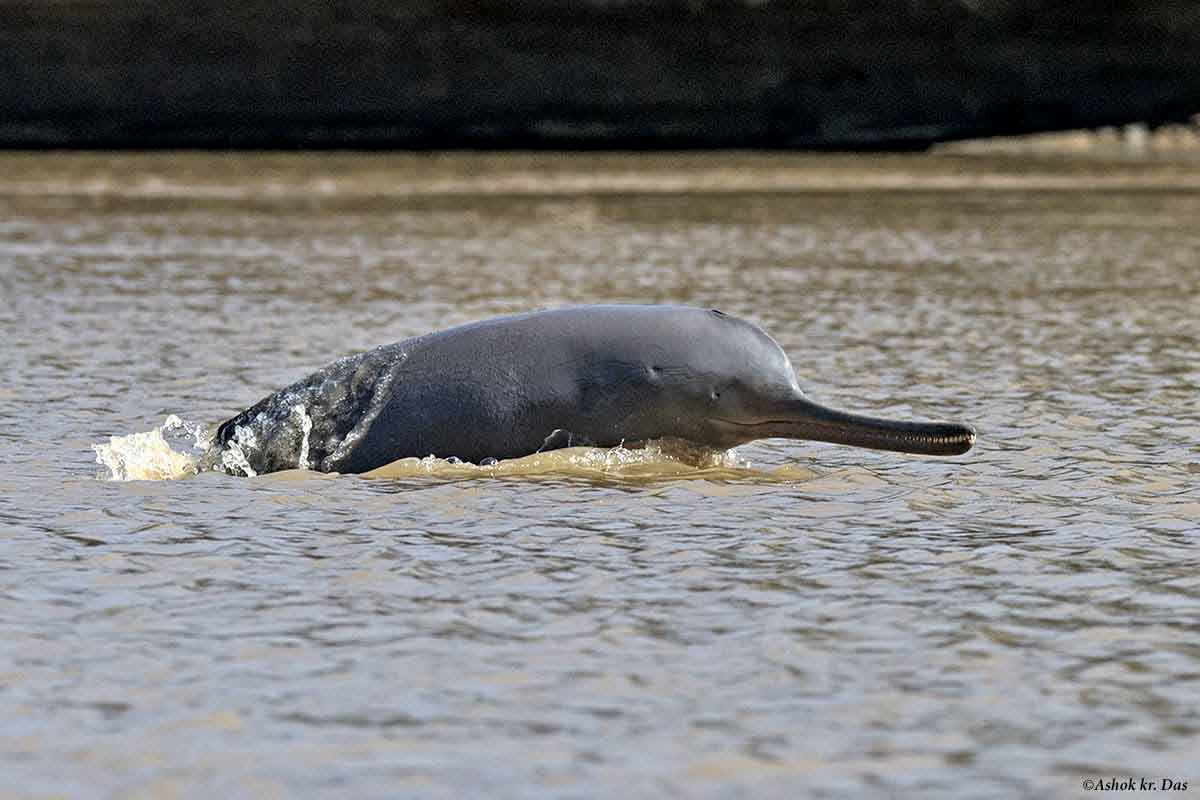Description

Disclaimer: Copyright infringement not intended.
Context
- Gill nets used indiscriminately in the Bhagirathi river by the fishermen communities have been killing the endangered Gangetic Dolphins over the years.
Dolphins and Porpoises
- Marine species are the most well-known, but there are several species that live in freshwater rivers.
- All are air-breathing, warm-blooded mammals that nurse their young.
- The difference between a dolphin and a porpoise has to do with their appearance: dolphins have longer snouts, bigger mouths, more curved dorsal fins, and longer, leaner bodies than porpoises.

About Dolphins
- Dolphins are one of the oldest creatures in the world along with some species of turtles, crocodiles and sharks.
- The Ganges river dolphin was officially discovered in 1801.
- Ganges river dolphins once lived in the Ganges-Brahmaputra-Meghna and Karnaphuli-Sangu river systems of Nepal, India, and Bangladesh.
- But the species is extinct from most of its early distribution ranges.
- The Ganges river dolphin can only live in freshwater and is essentially blind.
- They hunt by emitting ultrasonic sounds, which bounces off of fish and other prey, enabling them to “see” an image in their mind.
- They are frequently found alone or in small groups, and generally a mother and calf travel together.
- Calves are chocolate brown at birth and then have grey-brown smooth, hairless skin as adults.
- Females are larger than males and give birth once every two to three years to only one calf.
|
FACTS
- STATUS: Endangered
- SCIENTIFIC NAME: Platanista gangetica gangetica
- HABITATS: Freshwater rivers
|
- The Ganges river dolphin is important because it is a reliable indicator of the health of the entire river ecosystem.
- The government of India declared it the National Aquatic Animal in 2009.
Threats
Bycatch
- The habitat of the Ganges river dolphin is within one of the most densely populated areas of the world.
- Ganges river dolphins and people both favor areas of the river where fish are plentiful and the water current is slower.
- The Ganges river dolphin is still hunted for meat and oil, which are both used medicinally. The oil is also used to attract catfish in net fishery.
Pollution
- Industrial, agricultural, and human pollution is another serious cause of habitat degradation.
- High levels of pollution can directly kill prey species and dolphins, and completely destroy their habitat.
- As the top predator, river dolphins have been known to have high levels of persistent toxic chemicals in their bodies, which is likely to adversely affect their health.
Infrastructure
- Ganges river dolphins are divided into isolated groups because of the construction of more than 50 dams and other irrigation-related projects.
- This makes them susceptible to inbreeding and more vulnerable to other threats because they cannot move to new areas.
- Dolphins trapped above a dam are exposed to poaching, especially during dry summer months.
- Dolphins below a dam are threatened by heavy pollution, increased fishing activities and vessel traffic.
- They also have less food because dams disturb the migration, breeding cycles and habitat of fish and other prey.

River dolphins around the world
Amazon River Dolphin (Inia geoffrensis)
- Status: Endangered
- Also known as the boto or ‘pink river dolphin,’ the Amazon River dolphin swims throughout much of the famed South American river basin and the neighboring Orinoco river basin that stretches through Colombia and Venezuela.
- The species is characterized by its long snout and pale pink color.
- It has two recognized types or subspecies: Bolivian Bufeo (Inia geofferensis boliviensis) and Common Bufeo (Inia geoffrensis geoffrensis).
- Like its relatives elsewhere, the Amazon River dolphin faces challenges from development projects.
Tucuxi (Sotalia fluviatilis)
- Status: Endangered
- The Tucuxi is the smaller, gray counterpart to the Amazon River dolphin.
- The freshwater species is found throughout the Amazon and Orinoco river basins, and are believed to be guardians of rivers and symbols of good luck for their ability to navigate rocky and shallow sections of river, which guides people through safe routes.
- The Tucuxi travels in groups and, unlike the Amazon River dolphin, jumps out of the water.
- Tucuxis face the same threat as their close relatives, the Amazon river dolphins, such as gillnet mortality, deliberate killing for fish bait and development.
Indus River Dolphin (Platanista minor)
- Status: Endangered
- The remaining Indus River dolphins, known locally as the Bhulan, are only found swimming in the lower parts of the Indus river in Pakistan, with an addtional small, isolated population found in the Beas River in India.
- These functionally-blind dolphins rely on echolocation to navigate, communicate, and hunt prey in the muddy river waters.
- Beginning in the 1930s, the construction of numerous dams and barrages led to the initial decline of the Indus River dolphin by splitting the population into small groups, degrading their habitat, and impeding movements.
- The dolphins sometimes get entangled in fishing nets, stranded in irrigation channels, and face the dangers of pollution, too.
Irrawaddy Dolphin (Orcaella brevirostris)
- Status: Critically Endangered
- Unsustainable fishing practices remain the principal threat to the Irrawaddy dolphin.
- The species is not directly exploited, but can accidentally end up in fishing gear intended to capture other animals.
- Habitat degradation and population fragmentation due to dam development also impacts the dolphins.
- The vast and essential Mekong River accounts for up to 25% of the global freshwater catch and provides livelihoods for at least 60 million people.
Yangtze Finless Porpoise (Neophocaena asiaeorientalis)
- Status: Critically Endangered
- The Yangtze finless porpoise lives in the Yangtze River, the longest river in Asia.
- At one point, this porpoise shared the waters with the Baiji (Yangtze River dolphin)—a species declared functionally extinct in 2006. The Yangtze finless porpoise is known for its mischievous smile.
- Dredging, pollution, and boat strikes from shipping and transportation on the river threaten the finless porpoise. Sand mining and illegal fishing also impacted the species.

About Project Dolphin
- It is an Indian government initiative to conserve both riverine and oceanic dolphin species launched in 2021.
- It is under the Wildlife Institute of India, an autonomous body of the Ministry of Environment, Forest and Climate Change.
- It is modelled on Project Tiger.
- October 5th has also been designated as "National Dolphin Day" by the environment ministry.
- A dolphin breeding centre for the Gangetic river dolphin is planned for the Bengal region, specifically the stretch of the Ganges river between Farakka and Gangasagar, already home to 650 dolphins.
- India's dolphins are at risk of extinct due to a variety of factors, namely: strandings in canal systems, constructions of waterways, unchecked fishing activity using nylon nets, noise pollution from ships, amidsts other factors.
|
PRACTICE QUESTION
Q) Discuss the various threats that are faced by Dolphins around the world. What steps have been taken by the Indian government in this regard? (150 words)
|
https://www.thestatesman.com/bengal/gill-nets-causing-deaths-of-endangered-gangetic-dolphins-1503176537.html












